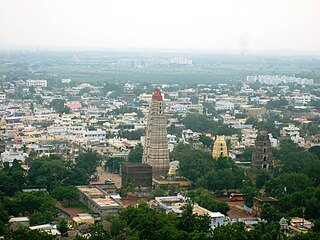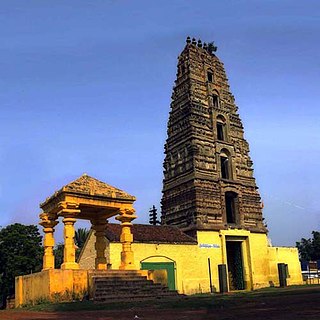
Mangalagiri is a major Sub-urban of Vijayawada in Guntur district of Indian state of Andhra Pradesh. The town is a part of Mangalagiri Tadepalli Municipal Corporation and part of Tenali revenue division. It and a part of Andhra Pradesh Capital Region. It is situated on National Highway 16 between Vijayawada and Guntur.

Telugu Talli is the female personification of Telugu people and their culture.

Amaravathi is a village on the banks of the Krishna River, in the Palnadu district of the Indian state of Andhra Pradesh. It is the headquarters of Amaravathi mandal, and forms part of the Andhra Pradesh Capital Region with its headquarters at new Amaravati 35 km (22 mi) east, whose name is also borrowed from that of the older Amaravathi.

The Kakatiya dynasty was an Indian dynasty that ruled most of eastern Deccan region in present-day India between 12th and 14th centuries. Their territory comprised much of the present day Telangana and Andhra Pradesh, and parts of eastern Karnataka, northern Tamil Nadu, and southern Odisha. Their capital was Orugallu, now known as Warangal.The Kakatiya rulers traced their ancestry to a legendary chief or ruler named Durjaya, a descendant of Karikala Chola.
The Reddi kingdom or Kondavidu Reddi kingdom was established in southern India by Prolaya Vema Reddi. Most of the region that was ruled by the Reddi dynasty is now part of modern-day coastal and central Andhra Pradesh. They helped the Bahmani Sultanate and defeated the Vijayanagar empire in the War of the Goldsmith's Daughter.

Hanamakonda is a major city and the district headquarters of Hanamkonda district in the Indian state of Telangana.Earlier Hanamakonda was a separate city, now The three urban cities Kazipet, Hanamakonda and Warangal are together known as Tri-Cities.The three cities are connected by National Highway 163

Rudrama Devi, also known by her regnal name Rudra-deva Maharaja, was a Kakatiya Queen who ruled substantial parts of present-day Telangana and Andhra Pradesh in southern India. She was among the few and the most successful female rulers of Indian history.

Thulluru is a Village in Guntur district of Indian state of Andhra Pradesh. It is located at a distance of 4 km from Krishna River and was a village in Thulluru mandal of Guntur district, prior to its denotification as gram panchayat.

Chebrolu is a village in Guntur district of the Indian state of Andhra Pradesh. It is the headquarters of Chebrolu mandal in Tenali revenue division. It was once a Buddhist site and territorial capital of Kakatiya dynasty. The Archaeological excavations revealed Buddhist artefacts of Satavahana and Ikshavaku period.

The recorded history of Andhra Pradesh, one of the 28 states of 21st-century India, begins in the Vedic period. It is mentioned in Sanskrit epics such as the Aitareya Brahmana. Its sixth-century BCE incarnation Assaka lay between the Godavari and Krishna Rivers, one of sixteen mahajanapadas. The Satavahanas succeeded them, built Amaravati, and reached a zenith under Gautamiputra Satakarni.
Jayapa or Jaya was a military commander under the Kakatiya king Ganapati-deva, whose core territory included the Telugu-speaking region in present-day Andhra Pradesh and Telangana.

Andhra Pradesh Capital Region is the metropolitan area of the capital city Amaravati of Andhra Pradesh in India. The region is spread across the districts of NTR, Krishna, Guntur, Palnadu, Bapatla and Eluru. It includes the major ancient cities of Vijayawada, Guntur and Tenali. Vijayawada is the largest city and headquarters of the region. It is one the most populated metropolitan areas in Andhra Pradesh. The region is under the jurisdiction of Andhra Pradesh Capital Region Development Authority and covers an area of 8,352.69 km2 (3,224.99 sq mi) under 58 mandals . The capital city Amaravati is an urban notified area and will cover 217.23 km2 (83.87 sq mi), within the Andhra Pradesh Capital Region.

Amaravati is the capital city of the Indian state of Andhra Pradesh. It is situated at the heart of the state, on the right bank of the river Krishna in Guntur district. It is near to Dharanikota, the ancient city site nearby, that served as the capital of Satavahana dynasty more than 2,200 years ago. The Andhra Pradesh Capital Region encompasses the cities of Guntur, and Vijayawada.

Pushpagiri Temple Complex is a temple complex located in Kadapa district in Andhra Pradesh, India. Founded around 7th Century CE, it houses some of the oldest temple congregations in the region.
Uddandarayunipalem is a village in Guntur district In Indian state of Andhra Pradesh. It was a village in Thullur mandal of Guntur district, prior to its denotification as gram panchayat. It also hosted the foundation stone ceremony of Amaravati, on 22 October 2015, when Prime Minister Narendra Modi laid the foundation stone of Amaravati.

Velagapudi is a village in Guntur district of the Indian state of Andhra Pradesh. It was a village in Thullur mandal of Guntur district, prior to its denotification as Gram Panchayat. Velagapudi is also the home to the temporary Secretariat of Andhra Pradesh.
The 2019–2024 Amaravati protests, simply known as Amaravati protests, are ongoing demonstrations in the Indian state of Andhra Pradesh triggered by the idea of changing the one capital of Amaravati already identified and developed partially, to three capitals of Amaravati, Visakhapatnam and Kurnool by the Government of Andhra Pradesh. This led to concerns that the decision would create chaos and insecurity for farmers who gave their fertile agricultural lands to the government in 29 villages of Guntur district. The protests began in Mandadam, Thullur, Uddandarayunipalem on 18 December 2019. In a few days, the protests spread across Andhra Pradesh Capital Region, in Andhra Pradesh. On 17 December 2020, series of events were done to mark the protests' anniversary.

Rudramadevi – Saatileni Maharaju is a Telugu-language historical television series that airs on Star Maa. The series is based on the life of Rani Rudrama Devi. The show is produced by Alind Srivastava and Nissar Parvez under the banner Peninsula Pictures. The show started airing from 18 January 2021 on Star Maa and also available digitally on Disney+ Hotstar. The series is written by Sakthi Sagar Chopra and Lakshmi Jaya Kumar. It is one of the expensive Telugu television series. Ananya Dwivedi portrayed the Young Rudrama Devi, with Anand playing the character Ganapati Devudu.

Ganapati-deva was the longest reigning monarch of the Kakatiya dynasty of southern India. He brought most of the Telugu-speaking region in present-day Andhra Pradesh and Telangana under the Kakatiya influence by war or diplomacy.
Amba-deva was a 13th-century chief who carved out an independent principality in present-day Andhra Pradesh in southern India. He was a member of the Kayastha family, whose members were vassals to the Kakatiya monarchs. Amba-deva succeeded his elder brother Tripurari as the Kayastha chief in 1272, and soon gave up allegiance to the Kakatiya queen Rudrama. He defeated several Kakatiya subordinates, and also fought against the neighbouring Pandyas and their vassals to carve out an independent principality with its capital at Valluru-pattana. A Kakatiya force sent by Rudrama's successor Prataparudra defeated him in mid-1291.
















